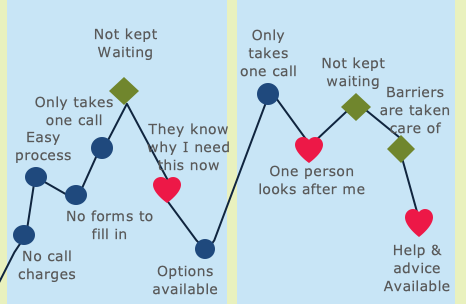To complement our series of QuickReads covering measurement, we will now explore Failure Demand (FD).…

ChangeWise Quick Read: Customer Journey Mapping
In this Quick Read we explore the benefits of Customer Journey Mapping, how it can help you to better understand your customer needs and drive service excellence.
What is it?
Customer Journey Mapping is a visual tool to help you understand how customers experience your product or service, and how they feel along the way. It captures the interactions between them and you.
What are the benefits of Journey Mapping?
Customer journey mapping can support organisations in gaining a better understanding of the buying experience from the customer’s perspective, it focuses on their pain points and actions to specific needs. The idea is to find and map out all the possible touchpoints, as the touchpoint with the lowest experience defines the overall level of customer satisfaction at the end of the journey. It is especially useful because it expresses the customer experience overtime, rather than just focusing on a snapshot.

The output of journey mapping can be used to drive customer acquisition, retention and revenue for your organisation.
How do I create a Customer Journey Map?
Customer Journey Mapping can be broken down into key steps:
1. Identify and understand who your customers really are. A customer journey map should focus on the experience of a single person with a single goal. This will avoid a map that is too general or complicated.
2. Understand your customer goals. What are their pain points that are encouraging them to want this new purchase? What is the ultimate goal?
3. Map out buyer touch points/interactions. We can use three categories to help better understand these interactions and how the customers emotional state alters with each touchpoint:
- Moment of Truth: Interactions where customers have an unusual amount of emotional energy invested in the outcome.
- Voting Point: Interactions where customers will select/choose to move to a competitor.
- Want/Need: Interactions customers expect to be in place.
The example below uses pet insurance as an example:

4. Identify customer pain points: where are the bottlenecks, missed opportunities, inefficiencies? Go back over the journey and capture these next to your touchpoints. We also recommend you consider the impact of each pain point – would it cause your customer to abandon their journey with you? This will help you determine where to focus efforts.
5. Prioritise and fix pain points: where are the biggest frustrations? Where are we failing customer expectation? Are there additional needs we are currently missing? Do we have non-value add processes?
6. Update and Improve: Develop an action plan to remove pain points.
In Summary:
A customer journey map is a visual representation of every experience your customer has with you. It helps to tell the story of a customer’s experience from initial engagement and hopefully into a long-term relationship.
Want to know more about how Customer Journey Mapping could help your organisation? Contact us at info@changewise.co.uk
ChangeWise believes employee engagement is the foundation for successful Change. Training and coaching your people to use simple continuous improvement techniques will enable your organisation to continuously adapt and stay ahead in a constantly changing and challenging environment.
For updates and interesting Lean Change insights, connect with us on LinkedIn.
Find out more about our Public Training Courses



